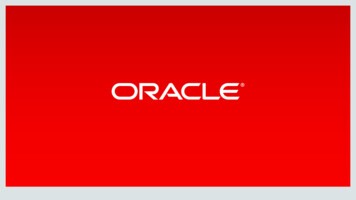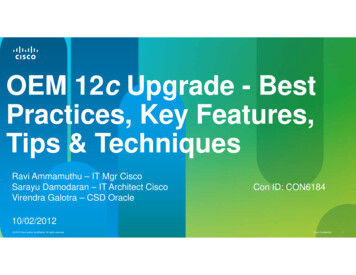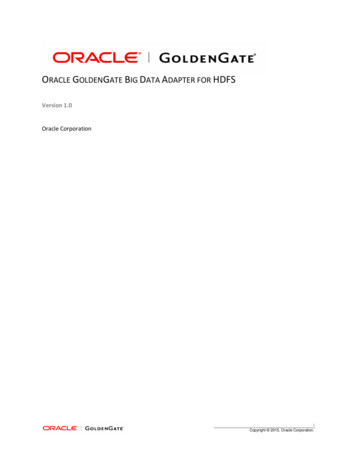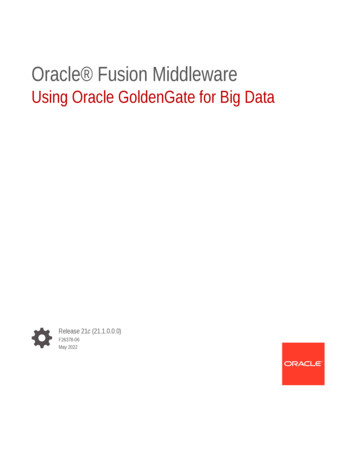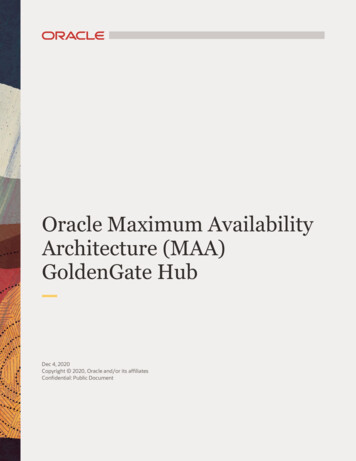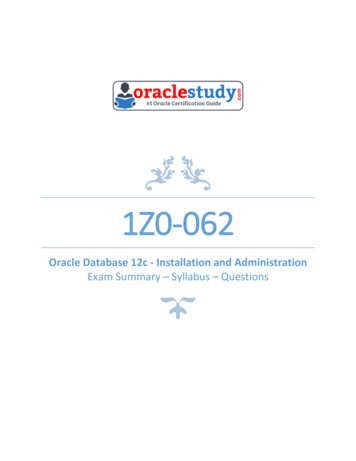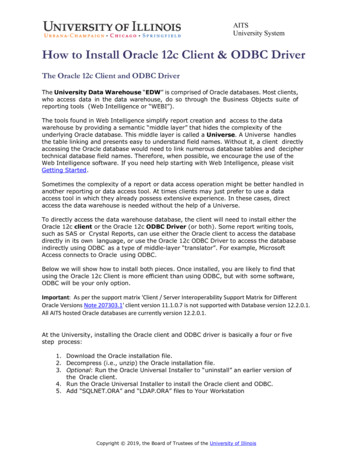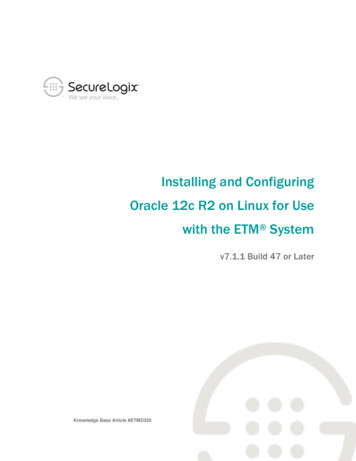
Transcription
ORACLE WHITEPAPERMARCH 2015ORACLE GOLDENGATE 12C:REAL-TIME ACCESS TOREAL-TIME INFORMATION
Oracle GoldenGate 12c:Real-Time Access to Real-Time InformationORACLE WHITE PAPER MARCH 2015
Table of ContentsExecutive Overview1Introduction2Oracle GoldenGate 12c2Architecture Overview5Associated Products11One Platform, Many Solutions13Continuous Availability13Real-Time Data Integration17Implement and Expand23Additional Oracle GoldenGate Features24Conclusion27.ORACLE GOLDENGATE 12C: REAL-TIME ACCESS TO REAL-TIME INFORMATION
Executive OverviewToday businesses are faced with an ever increasing volume and detail of data. As onlinetransactions happen anywhere, anytime, and we have increased the number of devices andconnectivity between these devices, turning this data deluge into an asset has become a keypriority for IT executives. The outcome of our fast-paced business environment is that much of thedata now diminishes in value if it is not used soon after it is generated. That’s why, to extractmaximum value out of dynamically changing data, organizations need to capture, analyze and actupon them with a near real-time speed. At the same time, organizations need to ensure highavailability and performance to support 24/7 operations. This desire to turn big data into actionableinsights and real value for the organization, and compete in a 24/7 world creates a need for realtime data integration and replication solutions that are easy to implement and have little to noimpact on business-critical applications.Oracle GoldenGate is used by major Fortune 500 companies and other industry leaders worldwideto support mission-critical systems for data availability and integration. Written for business projectowners, key stakeholders, and the entire IT organization, this white paper provides a detailed lookat Oracle GoldenGate 12c, its underlying technology architecture, and the typical solution usecases.Oracle GoldenGate 12c is now available for all major databases and operating systems. If youwould like to learn about the latest release in detail, please read “Oracle GoldenGate 12c NewFeatures White Paper” in the Oracle GoldenGate resource kit1 ORACLE GOLDENGATE 12C: REAL-TIME ACCESS TO REAL-TIME INFORMATION
IntroductionAs data volumes grow at an exponential rate, many organizations are looking at ways to leverage big data as anadvantage to their business. However research indicates that most organizations do not think they are preparedto leverage the enterprise data that they have. Data velocity in particular, seems to be a key challenge inhandling big data. In a recent study by Aberdeen Group that surveyed 247 executives 53% of respondents said1that too much crucial information is delivered too late .Today data is generated at a much faster rate due to online transactions taking place anywhere and anytime, aswell as due to the increased number of devices, along with the increased connectivity and communicationbetween these devices, also called “the Internet of Things”. Most of this data, though, loses its inherent valuevery fast by becoming less relevant and less effective in influencing operational decisions— unless it isintegrated, analyzed and consumed almost immediately.To extract value from such perishable data in a dynamically changing environment that includes a diversity ofsources, both on cloud and on premises, organizations need to capture, analyze and act upon them in near realtime. In addition they need to ensure that their systems can run uninterrupted to support customers 24/7 withreliable data meaning without experiencing interruptions in data availability, sluggish application performance, orstale data. There are four aspects to this challenge.» Availability. Business-critical applications and underlying data must be accessible at or near 24/7/365 withoutservice interruption or performance degradation» Reduced latency. Data must remain fresh. As it ages, data becomes less relevant and less valuable—day-olddata is often insufficient in today’s competitive landscape.» Heterogeneity and IT flexibility. Integration and replication solutions must have the flexibility to be easilymodified and distributed across diverse IT systems including on premises and cloud environments.» Transaction integrity. Data completeness and accuracy must be ensured as it is moved between systems.In short, companies need a platform that allows business applications to benefit from continuous access to realtime information in diverse IT environments, without compromising performance and data integrity or demandingsignificant resources to deploy and manage.Oracle GoldenGate 12c empowers organizations to capture, route, transform, and deliver transactional databetween heterogeneous databases and applications in real time with minimal overhead. Using unique real-time,log-based replication technology, Oracle provides high availability and real-time data integration solutions thatenable the management and movement of transactional data across the enterprise. Oracle GoldenGate isdesigned for low-impact and easy implementation, operation, modification, and extension to support the evolvingneeds of enterprise information management.Oracle GoldenGate 12cOracle GoldenGate 12c offers a real-time, log-based change data capture (CDC) and replication softwareplatform to meet the needs of today’s transaction-driven applications. The software provides capture, routing,transformation, and delivery of transactional data across heterogeneous environments in real time. OracleGoldenGate only captures and moves committed database transactions to insure that transactional integrity is1 Aberdeen Group – January 2012, survey of 247 executives - Data Management for BI – Big Data, Bigger Insight, Superior Performance2 ORACLE GOLDENGATE 12C: REAL-TIME ACCESS TO REAL-TIME INFORMATION
maintained at all times. The application carefully ensures the integrity of data as it is moved from the sourcedatabase or messaging system, and is applied to any number of target databases or messaging systems.The latest release sets GoldenGate further apart from competition by bringing extreme performance andadvanced capabilities such as intelligent and integrated data delivery and cloud-based real-time replication, whilesimplifying product deployment significantly.Table 1. Oracle GoldenGate Key Features and DifferentiatorsFeatureDetailReal-timeProvides continuous capture and delivery of data from sources to targets with end-to-enddata feedslow latency. Operates at high performance with low overhead even at high volumes.HeterogeneityCaptures and delivers data between a variety of relational, open systems/open source,and legacy databases on all major platforms. Captures from, and delivers to, JavaMessaging Service (JMS) based messaging systems.TransactionalMaintains the reliability and accuracy of transactional data as it is moved betweenintegritysystems by enforcing ACID properties and referential integrity.For more than two decades, industry leaders worldwide have put their trust in Oracle to enable the movementand management of their critical, rapidly changing transactional data.Figure 1. Oracle GoldenGate provides real-time access to real-time information through a comprehensive view of operationalsystemsDesigned for Real TimeOracle GoldenGate 12c enables the continuous, real-time capture, routing, transformation, and delivery oftransactional data across heterogeneous environments. As new or updated data is committed at the sourcesystem, it is continuously captured and applied to one or more target systems with low latency. Only changeddata is moved, so a lower burden is placed on the infrastructure.Oracle GoldenGate 12c offers several key advantages:» Continuous, real-time data movement with low latency» Negligible impact and overhead on source and target systems» No requirement for a middle-tier server» Tight integration with Oracle Data Integrator Enterprise Edition for complex transformations» No downtime for batch processing3 ORACLE GOLDENGATE 12C: REAL-TIME ACCESS TO REAL-TIME INFORMATION
» Complete data recoverability in case of outages or failures» Read-consistent data movement while maintaining referential integrity» Ability to apply transformations and mappings within the target database» Ability to use the same product in different topologies for different solutions such as continuous availability andzero-downtime upgrades and migrationsModular Decoupled ArchitectureThe Oracle GoldenGate 12c architecture consists of decoupled modules that can be combined across theenterprise to provide maximum flexibility, availability, and performance. This architecture facilitates the movementof transactional data in four simple, yet powerful steps.» Capture. Oracle GoldenGate captures changed data operations committed in the database transaction logs ina nonintrusive, high-performance, low-overhead implementation. Via the Oracle GoldenGate ApplicationAdapter, it can also capture messages from JMS message queues.» Route. Oracle GoldenGate can use a variety of means to route this changed data to one or more locations,and can compress and encrypt changed data prior to routing.» Transform. At any point prior to applying the data to the target system, Oracle GoldenGate can be used toexecute a number of built-in functions, such as filtering and transformations.» Delivery. While preserving transactional integrity, Oracle GoldenGate applies the changed data to one ormore targets with minimal latency. Transactional data can be delivered via selected Open DatabaseConnectivity compliant databases or through a specialized adapter to a JMS message queue or topic.Flexible Topology Support and Bidirectional ConfigurationsAs a result of its decoupled modular design, Oracle GoldenGate easily supports a wide variety of topologies.These include one-to-one, one-to-many, many-to-one, and many-to-many—for both unidirectional andbidirectional configurations.For unlimited scalability, cascading topologies can be created to eliminate any potential bottlenecks. By stagingspecific sets of database changes on the source or target system, different requirements can be met through asingle pass on the data source. Each set of staged data can contain unique or overlapping sets of data.Figure 2. Oracle GoldenGate supports numerous data propagation solutions to support real-time visibility across the enterprise.4 ORACLE GOLDENGATE 12C: REAL-TIME ACCESS TO REAL-TIME INFORMATION
Oracle GoldenGate Application Adapters allows Oracle GoldenGate to integrate with JMS messaging systemsfor increased flexibility in distributing real-time data. This capability, along with the flat file delivery feature, allowsOracle GoldenGate to provide different integration architectures to augment existing investments.Architecture OverviewA decoupled architecture addresses numerous problems inherent in tightly coupled alternatives. Process-toprocess coupling creates a dependency between data capture and delivery. For example, if delivery is slowerthan capture, capture activities must be held up. In the event of an unplanned outage, decoupling ensures thatthe non-impacted systems continue to operate.Tightly coupled or process-to-process implementations can impose scalability challenges. A great deal ofinterprocess checkpointing needs to occur to ensure no data is lost, thereby creating many more messages andstill more overhead. Network outages lasting more than a few minutes can also cause excessive resourceconsumption, because outstanding transactions need to be queued in memory and eventually swapped to disk.Neither the physical nor the virtual memory activities are persistent; therefore if the process fails, datainconsistencies—or even loss—ensues.By staging data in Trail Files, Oracle GoldenGate’s unique queuing mechanism, GoldenGate decouples the datasource and target for heterogeneous support. Unlike architectures that implement a tight process-to-processcoupling, this decoupled architecture allows each module to perform its tasks independently.Oracle GoldenGate also provides flexibility in the choice of hardware, operating system, and databases forsources and targets. For maximum flexibility and ease of use, customers can use different versions of Capture,Delivery, and Trail Files in the same implementation.Architectural ComponentsThe Oracle GoldenGate architecture consists of four distinct modules and components:» Oracle GoldenGate Capture» Oracle GoldenGate Trail Files» Oracle GoldenGate Delivery» Oracle GoldenGate ManagerFigure 3. Oracle GoldenGate’s modular architecture for database to database replication enables high speed, reliability andflexibility5 ORACLE GOLDENGATE 12C: REAL-TIME ACCESS TO REAL-TIME INFORMATION
Figure 4. Oracle GoldenGate for Big Data enables real-time transactional data streaming to big data systemFigure 5. Oracle GoldenGate Application Adapters supports capture and delivery of transactional changes from/to targets otherthan relational databases.Oracle GoldenGate CaptureThe Capture module grabs committed transactions resulting from insert, update, and delete operations executedagainst a database, and routes them for distribution. When used with the Oracle GoldenGate ApplicationAdapters for Java, transactions can also be captured from JMS messages.High-Speed, Low-Impact Data CaptureThe Capture module does not require any changes to be made to the source database or the application itsupports. To maintain optimal performance, the Capture module employs a range of change data capturetechniques against the source database. For instance, in most databases, changes are captured through directfile access to transaction logs (redo logs in Oracle and MySQL). For Teradata at the source, custom APIs havebeen developed to allow Oracle GoldenGate to capture committed transactions with the same efficiencies. TheOracle Certification Matrix contains the complete list of platforms supported by Oracle GoldenGate.6 ORACLE GOLDENGATE 12C: REAL-TIME ACCESS TO REAL-TIME INFORMATION
Transaction logs contain all changes made to the database and are automatically maintained by the databaseapplication independently of Oracle GoldenGate. Consequently, no additional tables are required to run theCapture module, and overhead is greatly reduced as compared with trigger-based capture techniques. Manycustomers report only single-digit percentage overhead when running the Capture module on the sourcedatabase. The Capture module can automatically adjust its transaction memory based on the size and number ofthe transactions it is capturing, which optimizes memory usage, allowing even lower overhead on the sourcesystems. When used with Oracle GoldenGate Application Adapters, the product also offers capabilities tocapture from JMS.Table, Row, and Column SelectivityWhen not all changed data from the source needs to be replicated to the target system—such as for real-timereporting purposes—the Capture module allows users to filter tables and rows based on user-defined criteria andignores the entries in the transaction log that don’t meet the end-user’s needs. Users can optionally select andapply transformation rules to specific columns via built-in Oracle GoldenGate functions, user-supplied code,stored procedures, or through Oracle Data Integrator Enterprise Edition.Efficient Network Use and Large Data VolumesThe Capture module can route transactions over WANs and LANs as well as the internet, and it can reducenetwork bandwidth requirements in a number of ways. Typically, the amount of data transmitted is only a fractionof the data that is generated by the database and stored in transaction logs. Because only committedtransactions are propagated, intermediate activities and rolled-back operations are not transferred. Traffic isoptimized by bundling individual records into larger, more-efficient packets and avoiding record-at-a-timebottlenecks. Several levels of data compression are available to further reduce the amount of network bandwidthrequired for transmission. Depending on data types, data compression can reduce byte transfer by 75 percent ormore.For scenarios requiring very large changed data volumes, users can deploy multiple Capture modules tominimize the lag between source and target systems. Additionally, customers running Capture on an OracleDatabase can take advantage of Integrated Capture, a multi-threaded capture mechanism that improvesperformance by interacting directly with a database log mining server to receive data changes. IntegratedCapture also provides users with the ability to reduce overhead on the source system by offloading the Captureprocess to an alternate location, such as the target. For more information on this feature please review in ourresource kit the white paper: Using Oracle GoldenGate 12c for Oracle Database.Checkpoints for Reliable Data DeliveryOracle GoldenGate creates a checkpoint at the last changed transaction whenever a commit boundary isencountered. This enables the delivery of all committed records to the target, even in the event of a restart orcluster failover. Checkpoints store the current position as processed by both the Capture and Delivery modules.Following a network or system outage, Oracle GoldenGate restarts from the last good checkpoint. OracleGoldenGate also persists uncommitted operations to disk to enable fast and simple data recovery for longrunning transactions in the event that the replication process is paused or interrupted.Oracle GoldenGate Trail FilesTrail Files contain the most recent changed data in a transportable, platform-independent format called theOracle GoldenGate Universal Data Format, and can be converted to XML and other popular formats for7 ORACLE GOLDENGATE 12C: REAL-TIME ACCESS TO REAL-TIME INFORMATION
consumption by different applications. Based on the requirements of the implementation, users can store TrailFiles on the target system, the source system, or both. Trail Files can be delivered to alternative queue types andapplication interfaces.Routing (Data Pumps)A separate Capture process continually scans the staging Trail File, awaiting new data. When new data isdetected in the staging Trail File, it is packaged for routing via TCP/IP to specific target locations. The targetlocation can be a single server disk location, multiple disk locations, or multiple servers and disk locations. Thisconfiguration enhances the fault tolerance and reliability of the overall Oracle GoldenGate environment. In theevent of a network failure (between the source and the target systems), Oracle GoldenGate can continue tocapture transactions because the data can be queued up locally in the Trail Files on the source, enhancing therecoverability in case of network failures.Fault tolerance is also greatly increased in such a configuration because any failure associated with one targethas no impact on the source capture or delivery to other targets—transactions will continue to be captured,routed, and delivered to the other targets even when one of them is down. Data can also be routed through anintermediate system, even if that system doesn’t have a database installed.Oracle GoldenGate uses TCP/IP, including IPV6, for sending data, so no geographical distance constraints areimposed between the source and target systems. Advanced options provide for encryption (using FIPS orBlowfish) and compression of the data within the TCP/IP packet. At the target locations, a communicationsprocess receives the incoming transmission from TCP/IP, decrypts and decompresses the data packet, andwrites the transaction information to a local trail file. Archival and Audit CapabilitiesDelivery processes can create an archive of purged information from the source database by transforming deleteand update records in Trail Files into inserts in a different location. For auditing and compliance purposes, OracleGoldenGate can also maintain a separate history table to track each update to individual records as they change.Oracle GoldenGate DeliveryThe Delivery module takes any changed transactional data that has been placed in a Trail File and immediatelyapplies it to the target database. In addition to supporting Oracle Database (including Oracle Exadata), MicrosoftSQL Server, IBM DB2, and most other popular databases. Through the use of Oracle GoldenGate ApplicationAdapters, Oracle GoldenGate also has the capability to publish changed data to a messaging system in XML orother formats, as well as provide data in flat files for third-party products, such as an ETL system. The OracleCertification Matrix contains the complete list of platforms supported by Oracle GoldenGate. Oracle GoldenGatefor Big Data enables streaming transactional data into big data systems, including Apache HDFS, Apache Hive,Apache Hbase, Apache Flume and more.Data Integrity and Transaction ConsistencyThe Delivery module applies captured database changes in the same order as they were committed in thesource database to provide data and referential integrity. In addition, it applies changes within the sametransaction context as they were on the source system for consistency on the target.Column Mapping and TransformationAs with Capture, users can configure the Delivery module via user-defined criteria to not only specify targettables but also individual rows and columns. By default, the Delivery module populates any target table column8 ORACLE GOLDENGATE 12C: REAL-TIME ACCESS TO REAL-TIME INFORMATION
with data from a source table column if the two columns share the same name, and this is also true of like-namedtables. However, you can easily configure Oracle GoldenGate to move data from a single table into multipletarget tables or vice versa. This can be used to normalize or denormalize data in a data warehouse or OLTPenvironment.Users can also define explicit mapping and transformation rules, ranging from simple column assignments tomore-complex transformations for which Oracle GoldenGate provides a suite of date, math, string, and utilityfunctions. The module also supports the use of stored database procedures and functions and enables implicitmapping and explicit rules to be combined. If additional transformations, data quality, aggregation, and otherfunctionality are required, Oracle GoldenGate 12c integrates with Oracle Data Integrator Enterprise Edition 12c tosupport end-to-end data integration.Optimized High-Speed, High-Volume Data DeliveryThe Delivery module provides a variety of techniques to optimize the posting of changed transactions to thetarget database. Oracle GoldenGate’s posting processes, where possible, run local to the target database,maximizing throughput by avoiding network limitations. In addition, where possible, updates are executed vianative database interfaces rather than through middleware, and internal caches are used to ensure fastexecution of repetitive statements.Multiple Delivery modules can be deployed to minimize lag time in the event of high data volumes during peakprocessing times or seasonality. This capture-route-transform-apply process runs continuously, so that the mostrecent transactions committed at the source are immediately moved and delivered to the target.Deferred DeliveryFor maximum flexibility, the Delivery module can apply data immediately or at a deferred time interval chosen bythe user, without losing transactional integrity. This allows an additional layer of data protection when needed andkeeps the secondary system at a consistent state behind the primary system. In this configuration, OracleGoldenGate routes the changed data to the Trail File on the target server but does not deliver it to the targetdatabase until a pre-determined time interval has elapsed.Integrated DeliveryCustomers delivering data to an Oracle Database 11g Release 11.2.0.4 or Oracle Database 12c Release12.1.0.1 and higher database, can improve performance and provide better scalability and load balancing byusing Integrated Delivery. Minimal changes are required to implement this change, which leverages the databaseparallel apply servers for automatic dependency aware parallel apply. With Integrated Delivery, there is no needfor users to manually split the delivery process into multiple threads and manage multiple parameter files. Formore information on using Integrated Delivery please see Using Oracle GoldenGate 12c for Oracle Database.Coordinated DeliveryCustomers delivering data to heterogeneous data stores (and Oracle Database versions before 11.2.0.4) whofind it necessary to split their delivery process into multiple threads can use the Coordinated Delivery featureavailable with Oracle GoldenGate 12c to eliminate the need to manage multiple parameter files. In addition torequiring a single parameter file for multiple Delivery processes, Coordinated Delivery also automatically providescoordination across selected events that require ordering, including DDL, Primary Key updates, EMI andSQLEXEC.9 ORACLE GOLDENGATE 12C: REAL-TIME ACCESS TO REAL-TIME INFORMATION
Delivery using Oracle GoldenGate Application AdaptersCustomers who need to apply transactional changes to targets other than a relational database can takeadvantage of the Oracle GoldenGate Adapters for Java and Flat File. These adapters provide a variety of optionsfor integration with Oracle GoldenGate including delivery to JMS, flat files, and Java APIs.Oracle GoldenGate can publish changed data to JMS queues and topics by using Oracle GoldenGateApplication Adapters for Java. After capturing from source database transaction logs, Oracle GoldenGateconverts captured records into JMS text and map messages (name-value pairs), and it formats text in any way,including XML. Changed data can be published as transactions with preserved integrity or as individual databaseoperations such as inserts or deletes. This allows Oracle GoldenGate to provide improved support for SOA andenable event-driven architectures.Using Oracle GoldenGate Application Adapters for Flat File, Oracle GoldenGate can publish changed data in theform of flat files to integrate with third-party data management products such as ETL. For those ETL systems thatperform faster reading files than scanning staging tables, this method minimizes storage resources and systemmaintenance. It also enables the user to decrease the data latency by configuring the frequency of microbatches. Oracle GoldenGate has the ability to provide the data in a variety of formats, including delimited textfiles and binary files, to create the optimal feeding mechanism. Note that an out-of-the-box solution for delivery toOracle Coherence is included with Oracle TopLink Grid, although it is also possible to create a custom solutionusing the GoldenGate adapters.To learn more about these adapters, please consult Oracle GoldenGate Adapters for Java and Flat File.Streaming Transactional Data to Big Data Systems with Oracle GoldenGate for Big DataOracle GoldenGate for Big Data provides optimized and high performance delivery to Flume, HDFS, Hive andHbase to support customers with their real-time big data analytics initiatives. Oracle GoldenGate for Big Dataincludes Oracle GoldenGate for Java, which enables customers to easily integrate to additional big data systems,such as Oracle NoSQL, Apache Kafka, Apache Storm, Apache Spark, and others.The below diagram illustrates a general high level architecture for integrating with Hadoop.Figure 6. High-level architecture for feeding transactional data into Hadoop using Oracle GoldenGate and Oracle GoldenGatefor Big Data10 ORACLE GOLDENGATE 12C: REAL-TIME ACCESS TO REAL-TIME INFORMATION
Oracle GoldenGate ManagerThe Oracle GoldenGate Manager module is the controlling process that performs a variety of administrative,housekeeping, and reporting activities, including» Starting the Capture and Delivery modules» Critical, informational event, and threshold reporting» Resource management» Trail File managementThe Manager module executes requests on demand as well as unattended. For example, it can be used torestart Oracle GoldenGate components as well as send latency information. The module can be configured torecycle Trail File data when no longer needed, providing insurance against inadvertent disk-full conditions andoffering an alternative to error-prone manual housekeeping procedures. Oracle GoldenGate 12c offers increasedtransaction tracing flexibility to easily identify bottlenecks and tune the Oracle GoldenGate implementation foroptimum performance.For enhanced management of Oracle GoldenGate 12c processes and solutions, customers should consideradding the Management Pack for Oracle GoldenGate described later is this paper.Associated ProductsThere are two primary products that augment Oracle GoldenGate to enhance a customer’s real-time informationplatform:» Management Pack for Oracle GoldenGate. A tool for visually deploying and managing Oracle GoldenGateprocesses across the enterprise.» Oracle GoldenGate Veridata. A data comparison utility that quickly compares data between two onlinedatabases and reports any discrepancies (can run as a standalone product).Management Pack for Oracle GoldenGateManagement Pack for Oracle GoldenGate is a centralized, server-based graphical enterprise application thatoffers an intuitive way to define, configure, manage, monitor and report Oracle GoldenGate processes. Itleverages the management services of the core Oracle GoldenGate platform to help users reduce thedeployment time for their continuous availability and real-time data integration configurations.Management Pack for Oracle GoldenGate includes a license for the plug-in for Oracle Enterprise Manager aswell as for both of the monitoring and configuration products, Oracle GoldenGate Monitor and OracleGoldenGate Director, respectively. Both are server-based products that feature an intuitive graphical interface,each with a specific focus. As shown
The Oracle GoldenGate architecture consists of four distinct modules and components: » Oracle GoldenGate Capture » Oracle GoldenGate Trail Files » Oracle GoldenGate Delivery » Oracle GoldenGate Manager Figure 3. Oracle GoldenGate's modular architecture for database to database replication enables high speed, reliability and flexibility
